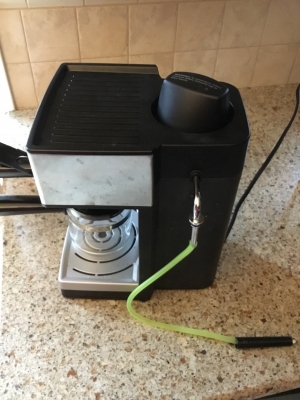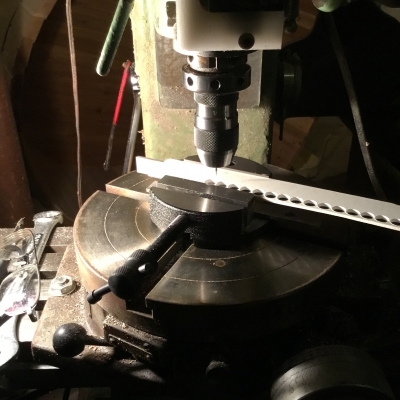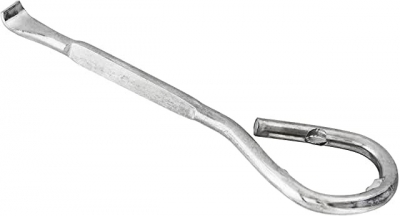Welcome to our forum. A Message To Our New and Prospective Members . Check out our Forum Rules. Lets keep this forum an enjoyable place to visit.
Currently working on errors from the latest (SimplePress) forum update. Many issues have been resoled and others are being worked on. Thank you for your patience.
 Topic RSS
Topic RSS



 (0 votes)
(0 votes) Regulars
 Offline
Offline

@Fiddlerman and others. The gun goes for $150. I found the handle (import glue dispenser) for $10 and 30 cc plastic dispensing tubes for $5. I am going to substitute a laboratory block heater ($15 on eBay) and see if it works.
It is likely cheaper to purchase some aluminium tubes from the maker of the z-gun than it would be to attempt to make some. Of course, I will try to refill them with shellac on my own then the time comes.
Success is the progressive realisation of a worthy ideal. —Earl Nightingale.
Regulars
 Offline
Offline

I purchased two metal tubes of shellac for $16 each. Vendor also thought boy should use a re-solder air torch instead of a butane torch for greater safety. I completely agree.
We are currently working on a hard rubber clarinet. I gave a section a little polish with paste wax and it looks great. I read that leather black dye can be used to restore hard rubber that has turned green. So many tricks, so little time to learn.
Success is the progressive realisation of a worthy ideal. —Earl Nightingale.
Regulars
 Offline
Offline

Just got done doing a clarinet repad using shellac suspended in alcohol. Just dipped it on the back of the pad and interior of the key cup with the provided brush (think nail polish), allowed it to dry for a few minutes, put pad in cup, and secured with a few seconds of heat with a butane torch. Very quick, very neat, and worked great. Sometimes, it pays to think outside of the box.
Success is the progressive realisation of a worthy ideal. —Earl Nightingale.
Regulars
 Offline
Offline

I made a very slight modification (basically added a piece of silicone tubing to the steaming tube) to a Mr. Coffee expresso maker and turned it into a steam cleaner. I am still using the existing metal nozzle and repurposed a safety shield for the steam tube for a wand handle. It works amazingly well. A prodigious amount of steam can be procured from a few ounces of water. I am using distilled water to prolong the life of the expresso maker.
Silicone tubing has a melting point of about 650 F. I would not attempt to substitute a different material for the tubing.

Success is the progressive realisation of a worthy ideal. —Earl Nightingale.
Regulars
 Offline
Offline

Regulars
 Offline
Offline





Interesting. My great-aunt's "boyfriend" gave me a fife when he knew I was a musician (this would have been around 1970 when he would have been 80). Nice of him, except that it was so filthy my parents wouldn't let me play it. I think they threw it away. It was ebony, maybe dated to about 1900, and he last played it before WWI, I guess!
Andrew
Verified human - the ignominy!
Regulars
 Offline
Offline

Hi @Gordon Shumway and others. I always thought of a harmonica as a sort of low tech bioreactor. I bet I could clean one with this thing, but I have no desire to purchase a used harmonica to test. I guess even I have my limits for science. I do have an expanding watch band that must have been the daily ware of a coal miner. That will be interesting.
I just procured some USMC Black leather dye to recondition the color of a hard rubber clarinet.
Success is the progressive realisation of a worthy ideal. —Earl Nightingale.
Regulars
 Offline
Offline

I applied a coat of USMC Black leather dye on a stripped section of a hard rubber clarinet tonight. Looked very bad, much worse than before the treatment. Liked streaked flat black with no definition. Felt that I ruined the instrument, which is a very unusual feeling for me. Had no clue how long the dye should be kept on the surface, so I gave it two hours. Rubbed dye off with a cotton cloth. The body looks terrific.
Success is the progressive realisation of a worthy ideal. —Earl Nightingale.
Regulars
 Offline
Offline

Success is the progressive realisation of a worthy ideal. —Earl Nightingale.
Regulars
 Offline
Offline

Cleaning the fabric in a clarinet case is my new project. Otherwise, it is easy to spend $40 to case a $10 clarinet.
Equipment
wet/dry shop vac
plastic water bottle with a nail hole through top, filled with water
32 fluid oz. spray bottle
bristle brush
Cleaner Ingredients
6 fluid oz. Dawn Ultra Platinum
10 fluid oz. Ethanol
1 fluid oz. Oxy Clean Max Force
19 fluid oz. warm distilled water (or to fill spray container)
Procedure
Spray cleaner on case fabric and brush.
Allow 10 to 15 minutes of reaction time.
Apply water from bottle on fabric and immediately vacuum, working in tandem until all cleaner and dirt is removed from fabric. Once clean, continue to use vacuum alone until surface is dry.
Repeat process if required.
Edit: The combined perfumes of the ingredients is overpowering and lingers in the work space for days. My wife puts up with a lot and it was too much for her. The materials were not effective on ridding the case fabric of stale cork grease. A fail in all aspects.
Success is the progressive realisation of a worthy ideal. —Earl Nightingale.
Regulars
 Offline
Offline

An update on the clarinet project. I have now found that there was not a standard on clarinet pad diameters (and thicknesses). Sets of “generic” fish bladder pads are cheap, but finding the frequent pad that will not accommodate the provided key pad holder necessitates another package delivery “across the pond.” No way to run an efficient rail road. Merchants by pass this obstacle by the purchase of a boxed pad assortment, which costs scores of times more than my purchase price of a used clarinet.
What to do?
I think that expanded pvc foam has the makings of a good resilient pad, but the chlorine component of the compound prevents the use of a laser cnc (per my inquiry on another thread on this forum). Punch and die sets are not economically available in the range of diameters needed. Cricut has a “Maker” product that could cut 3 mm stock while using a computer driven sketch that seems ideal for my purpose, but costs about $500.
I do have a mini milling machine and a rotary table, but attempts to hold and mill small circles was very inefficient. Slicing pvc foam using a chuck held exacto knife seemed easy but proved too flexible for consistent cuts.
Miniature carbide blades used in cricut and Roland vinyl cutters are surprisingly inexpensive and work well when chucked. An inexpensive import rotary table vice makes for quick foam material holding. See photo below.

Success is the progressive realisation of a worthy ideal. —Earl Nightingale.
Regulars


Just a thought, @Irv - why not try pinching the xPVC foam between two lengths of round bar of the required diameter, crushing it hard enough that you can then cut around with a sharp blade. When released, it just might have the edge profile you desire. I'm thinking one piece in a lathe chuck, the other in the tailstock drill chuck, drive them together and then cut around. The same could be done with a drill press and machine vice, but with hand precision on the coaxial alignment.
Peter
"It is vain to do with more that which can be done with less" - William of Ockham
"A crown is merely a hat that lets the rain in" - Frederick the Great
Regulars
 Offline
Offline

@peter and others. Good thought but I do not think I would save much time over current method. I forgot to mention that I substituted a Allen headed bolt for the handle in the rotary table and actuate with a variable speed portable drill. The upper section of the clarinet uses two diameter groups of about five pads each. The rest of the lot are all uniquely sized (about 18 total pads). I ended up making 3 sets of pads (for a Vito plastic clarinet) in less than two hours. Not an economic use of time, but enjoyable.
I likely have over 60 clarinet makes and models. I am going to catalog pad diameters and thicknesses from now on to set up a database.
The student wants to use colored plastic for the pads, and I found blue, red, and yellow for him. White works for me.
Success is the progressive realisation of a worthy ideal. —Earl Nightingale.
Regulars


Regulars
 Offline
Offline

An update regarding making pvc foam clarinet pads.
I purchased (now several) used cricut computerized cloth cutting machines. The material is attached to a sticky plastic pad and is cut with a miniature carbide blade in a rigid frame. The manufacturer likely sells the machine at a loss; but gathers revenue from cartridges containing fonts and shapes.
My need is for precisely sized circles, and the long list of cartridges had nothing of use (the machine has a very gross sizing dial which is of no use to me).
I noticed that the cricut had a form of USB port so I had hopes of tricking it to accept graphic content from something other than a sole source cartridge. It can, and inexpensive software to do so is commercially available in the name of “Sure Cuts Alot 2.”
The software runs on later (to me) versions of Windows (it happily loaded onto a Windows 7 laptop in my possession). The firmware of the cricut needs to be updated so that it will recognise the software and this simple procedure took 6 minutes per machine. The machine needs a cartridge (of any flavor) to accept commands from the software. Thus far, I think that it will do precisely what I need. I can even nest hole cutting so I can cut a small hole within a larger circle (the donut shape required for flute and saxophone pads).
More complex shapes (such as required for a gasket) are likely beyond the ability of the software. But files can be imported (I will likely require an intermediate program to convert .dwg format from Autocad).
Success is the progressive realisation of a worthy ideal. —Earl Nightingale.
Regulars


Irv said
An update regarding making pvc foam clarinet pads. ......
More complex shapes (such as required for a gasket) are likely beyond the ability of the software. But files can be imported (I will likely require an intermediate program to convert .dwg format from Autocad).
It sounds like you have the situation largely under control, @Irv.
Try some of the many open-source CAD packages; they have extensive import / export tools for dealing with everyone else's drawing formats, and Autocad files are invariably readable (and writable) by them and from there exported as any of a wide range of competitor files.
Peter
"It is vain to do with more that which can be done with less" - William of Ockham
"A crown is merely a hat that lets the rain in" - Frederick the Great
1 Guest(s)


 Log In
Log In Register
Register























